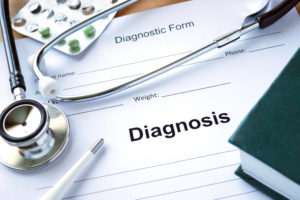 This type of comment appears in scleroderma patient support groups all the time. And it is quite possible that if you were to look at the patient’s chart, this is exactly what you would see in their list of diagnostic codes. While this list may be accurate, sometimes it is not and it’s worth spending a little time explaining why this might be the case, especially for patients with systemic scleroderma.
This type of comment appears in scleroderma patient support groups all the time. And it is quite possible that if you were to look at the patient’s chart, this is exactly what you would see in their list of diagnostic codes. While this list may be accurate, sometimes it is not and it’s worth spending a little time explaining why this might be the case, especially for patients with systemic scleroderma.
Systemic scleroderma, as many patients can attest to, can be very difficult to diagnose, often taking many years from first symptoms to a final, accurate diagnosis. While this can sometimes occur with diffuse scleroderma, which can start with many different symptoms, it is usually much more of a problem with the limited and overlap forms of scleroderma where symptoms develop more slowly and skin changes, if any, may not be present for years.
The basic problem is that scleroderma can have symptoms that are non-specific and can occur in other autoimmune diseases. For example, fatigue is a common symptom of MANY diseases, not just autoimmune diseases. Muscle aches and joint pains can arise in lupus and rheumatoid arthritis. Some GI symptoms look like irritable bowel symptoms. Raynaud’s can occur with lupus, autoimmune Hashimoto’s, Sjögren’s, Buerger’s disease, and so forth.
If a patient comes into a primary care provider with some of these symptoms, the provider will typically order a series of tests and in some cases send people to specialists. Depending on the test results (and there can be major problems with ANA and antibody testing – this topic is discussed in the ANA and Antibody series), the patient may initially be diagnosed with lupus or RA or something that is not autoimmune but fits at least some of the symptoms. Over time, other symptoms develop that eventually results in the patient being sent do a specialist who is finally able to figure out that the patient has one of the forms of systemic scleroderma – a single diagnosis that can easily account for most or all of the symptoms that started this long diagnostic journey.
Unfortunately, in many clinical settings, what is not done is to eliminate the previous (incorrect) diagnoses from the patient’s record. As a result, the diagnostic list becomes cumulative with more and more diagnoses being added over time. This creates a great deal of confusion for the patient, of course, but it can also create confusion for other doctors or medical personnel looking at the diagnostic coding for the patient.
If you have gone through a long series of preliminary diagnoses before getting a definitive diagnosis of one of the forms of systemic scleroderma, talk to your provider about this on your next visit. There may be good reasons for retaining multiple diagnoses in some cases, but if not, removing those extra, incorrect diagnostic codes from your chart will help to simplify things for you and future providers.

ok just went to the doctor the markers are there he feels it is a mild case. (celecoxib) for the burning in my hands it works. still have headaches, nose bleeds, fatigue, can’t swallow more than baby foods still choke on fluids, and soft foods even with mint before and after i eat. doing tai chi, morning and night, walking with my walker, it feels relieving to know your doctor believes you and its not in your head. having the jack hammer esophagus is hard conservative care. they will find out if there is any link to the platybasia in my brain.
MY NAME IS JULIE 48 YEARS OLD JUST HAD BARIUM TEST, MONDAY WE ARE DOING ENDOSCOPY. THEY THINK CREST DISEASE. I HAVE FIBRO, CHRONIC FATIGUE, PLATYBASIA, CHIARI MALFORMATION HAD ACDF LAST YEAR. DIAGNOSED WITH RAYNAUD’S 2 MONTH AGO AND IT HAS GONE WILD IN MY HANDS THEY ARE PURPLE AND NO PAIN MEDS WORK. I AM DOING PT AT HOME WITH DIFFERENT TEXTURES CAN’T FEEL THEM MY HANDS ARE SO NUMB. CAN’T STAND COLD WATER, HOT WATER WHEN IAM DOING DISHES 2 PAIRS OF GLOVES ON WHEN I TAKE THEM OFF I LOOK LIKE MY HANDS ARE BURNED. I CAN NOT FEEL THE TEMPERATURE WHEN I TAKE A BATH ITS LIKE THE WATER IS NOT THERE. NOW IN MY FEET NUMB AND TINGLING.